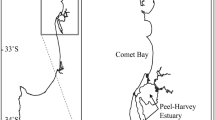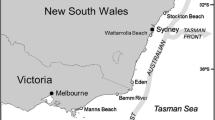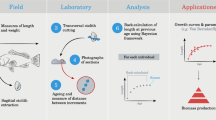Abstract
Fundulus grandis (Baird and Girard), the Gulf Killifish, is an abundant species throughout the marshes of the northern Gulf of Mexico. Its wide distribution and high site fidelity makes it an ideal indicator species for brackish and salt marshes, which experience a variety of anthropogenic disturbances. Despite the ecological, commercial, and scientific importance of F. grandis, age determination methods have not been validated and little is known of its growth pattern. By combining a tag-recapture study with a chemical marker to stain otoliths, we validated an ageing method for F. grandis adults (49–128 mm TL) using whole sagittal otoliths and determined growth rates of recaptured individuals in winter (n = 58) and summer (n = 36) in Louisiana. Mean somatic growth in length was significantly greater during the winter (0.085 mm d−1) than summer (0.054 mm d−1). In contrast, mean otolith growth was significantly greater in summer (1.37 μm d−1) than winter (0.826 μm d−1). The uncoupling of somatic and otolith growth may be primarily attributed to warm summer temperatures, which led to enhanced otolith growth while simultaneously reducing somatic growth. Fundulus grandis was aged to a maximum of 2.25 years. The parameters of the von Bertalanffy growth model were estimated as: L ∞ = 87.27 mm, k = 2.43 year−1, and t 0 = −0.022. These findings reveal essential age and growth information for F. grandis and provide a benchmark to evaluate responses to environmental disturbances.








Similar content being viewed by others
Change history
07 June 2018
The doi for the dataset mentioned in the acknowledgements is incorrectly cited as doi: https://doi.org/10.7266/N7SF2T32. The correct doi for this dataset is https://doi.org/10.7266/N7NZ85M4.
References
Able KW, Fahay MP (2010) Ecology of estuarine fishes. Johns Hopkins University Press, Baltimore
Able KW, Hata D (1984) Reproductive behavior in the Fundulus heteroclitus-F. grandis complex. Copeia 1984:820–825. doi:10.2307/1445323
Able KW, Hagan SM, Brown SA (2006) Habitat use, movement, and growth of young-of-the-year Fundulus spp. in southern New Jersey salt marshes: comparisons based on tag/recapture. J Exp Mar Biol Ecol 335:177–187
Able KW, Vivian DN, Petruzzelli G, Hagan SM (2012) Connectivity among salt marsh subhabitats: residency and movements of the mummichog (Fundulus heteroclitus). Estuar Coasts 35:743–753
Able KW, López-Duarte PC, Fodrie FJ et al (2015) Fish assemblages in Louisiana salt marshes: effects of the Macondo oil spill. Estuar Coasts 38:1385–1398. doi:10.1007/s12237-014-9890-6
Araya M, Medina M, Arancibia H (2003) Preliminary results of the empirical validation of daily increments in otoliths of jack mackerel Trachurus symmetricus (Ayres, 1855) marked with oxytetracycline. Sci Mar 67:471–475
Barber MC, Jenkins GP (2001) Differential effects of food and temperature lead to decoupling of short-term otolith and somatic growth rates in juvenile King George whiting. J Fish Biol 58:1320–1330. doi:10.1006/jfbi.2000.1539
Barger LE (1985) Age and growth of Atlantic croakers in the northern Gulf of Mexico, based on otolith sections. T Am Fish Soc 114:847–850
Battaglia P, Malara D, Romeo T, Andaloro F (2010) Relationships between otolith size and fish size in some mesopelagic and bathypelagic species from the Mediterranean Sea (Strait of Messina, Italy). Sci Mar 74:605–612. doi:10.3989/scimar.2010.74n3605
Beamish RJ, McFarlane GA (2000) Reevaluation of the interpretation of annuli from otoliths of a long-lived fish, Anoplopoma fimbria. Fish Res 46:105–111. doi:10.1016/s0165-7836(00)00137-5
Beddington JR, Kirkwood GP (2005) The estimation of potential yield and stock status using life-history parameters. Philos T R Soc B 360:163–170. doi:10.1098/rstb.2004.1582
Beverton RJH, Holt SJ (1957) On the dynamics of exploited fish populations. Fishery Investigations Series II, 19. HSMO, London
Bonnet X, Bradshaw D, Shine R (1998) Capital versus income breeding: an ectothermic perspective. Oikos 83:333–342. doi:10.2307/3546846
Boschung HT, Mayden RL (2004) Fishes of Alabama. Smithsonian Books, Washington D.C
Brothers EB (1979) Age and growth studies on tropical fishes. In: Roedel PM, Saila SB (eds) Stock assessment for tropical small-scale fisheries. University of Rhode Island Press, Rhode Island, pp 119–136
Brown ML, Powell JL, Lucchesi DO (2002) In-transit oxytetracycline marking, nonlethal mark detection, and tissue residue depletion in yellow perch. N Am J Fish Manage 22:236–242
Brown CA, Gothreaux CT, Green CC (2011) Effects of temperature and salinity during incubation on hatching and yolk utilization of Gulf killifish Fundulus grandis embryos. Aquaculture 315:335–339. doi:10.1016/j.aquaculture.2011.02.041
Burnett KG, Bain LJ, Baldwin WS et al (2007) Fundulus as the premier teleost model in environmental biology: opportunities for new insights using genomics. Comp Biochem Phys D 2:257–286. doi:10.1016/j.cbd.2007.09.001
Campana SE (1999) Chemistry and composition of fish otoliths: pathways, mechanisms and applications. Mar Ecol Prog Ser 188:263–297. doi:10.3354/meps188263
Campana SE (2001) Accuracy, precision and quality control in age determination, including a review of the use and abuse of age validation methods. J Fish Biol 59:197–242. doi:10.1006/jfbi.2001.1668
Campbell JS, MacCrimmon HR (1970) Biology of the emerald shiner Notropis atherinoides Rafinesque in Lake Simcoe, Canada. J Fish Biol 2:259–273
Chesney EJ, Baltz DM, Thomas RG (2000) Louisiana estuarine and coastal fisheries and habitats: perspectives from a fish's eye view. Ecol Appl 10:350–366
Chilton DE, Beamish RJ (1982) Age determination methods for fishes studied by the Groundfish Program at the Pacific Biological Station. Can Spec Publ Fish Aquat Sci 60:1–102
Choat JH, Robertson DR, Ackerman JL, Posada JM (2003) An age-based demographic analysis of the Caribbean stoplight parrotfish Sparisoma viride. Mar Ecol Prog Ser 246:265–277. doi:10.3354/meps246265
Dibble KL, Meyerson LA (2012) Tidal flushing restores the physiological condition of fish residing in degraded salt marshes. PLoS One 7:e46161. doi:10.1371/journal.pone.0046161
Dubansky B, Whitehead A, Miller JT, Rice CD, Galvez F (2013) Multitissue molecular, genomic, and developmental effects of the Deepwater Horizon oil spill on resident Gulf killifish (Fundulus grandis). Environ Sci Technol 47:5074–5082. doi:10.1021/es400458p
Duffy WJ, McBride RS, Hendricks ML, Oliveira K (2012) Otolith age validation and growth estimation from oxytetracycline-marked and recaptured American shad. T Am Fish Soc 141:1664–1671. doi:10.1080/00028487.2012.720631
Farley JH, Williams AJ, Clear NP, Davies CR, Nicol SJ (2013) Age estimation and validation for South Pacific albacore Thunnus alalunga. J Fish Biol 82:1523–1544. doi:10.1111/jfb.12077
Fey DP (2005) Is the marginal otolith increment width a reliable recent growth index for larval and juvenile herring? J Fish Biol 66:1692–1703. doi:10.1111/j.1095-8649.00716.x
Fielder DG (2002) Methodology for immersion marking walleye fry and fingerlings in oxytetracycline hydrochloride and its detection with fluorescence microscopy. Michigan Department of Natural Resources, Lansing
Finley MA, Courtenay SC, Teather KL, van den Heuvel MR (2009) Assessment of northern mummichog (Fundulus heteroclitus macrolepidotus) as an estuarine pollution monitoring species. Water Qual Res J Can 44:323–332
Fodrie FJ, Able KW, Galvez F, Heck KL, Jensen OP et al (2014) Integrating organismal and population responses of estuarine fishes in Macondo spill research. Bioscience 64:778–788
Fowler AJ (1990) Validation of annual growth increments in the otoliths of a small, tropical coral reef fish. Mar Ecol Prog Ser 64:25–38. doi:10.3354/meps064025
Fowler AJ, Doherty PJ (1992) Validation of annual growth increments in the otoliths of two species of damselfish from the southern Great Barrier Reef. Aust J Mar Fresh Res 43:1057–1068
Francis RICC, Paul LJ, Mulligan KP (1992) Ageing of adult snapper (Pagrus auratus) from otolith annual ring counts: validation by tagging and oxytetracycline injection. Aust J Mar Fresh Res 43:1069–1089
Frisk MG, Miller TJ, Dulvy NK (2005) Life histories and vulnerability to exploitation of elasmobranchs: inferences from elasticity, perturbation and phylogenetic analyses. J North Atl Fish Organ 35:27–45
Fritz ES, Garside ET (1975) Comparison of age composition, growth, and fecundity between two populations each of Fundulus heteroclitus and F. diaphanus (Pisces: Cyprinodontidae). Can J Zoolog 53:361–369
Froese R, Pauly D (eds) (2016) FishBase: world wide web electronic publication (Version 06/2016). www.fishbase.org. Accessed 1 Aug 2016
Galleher SN, Gilg MR, Smith KJ (2010) Comparison of larval thermal maxima between Fundulus heteroclitus and F. grandis. Fish Physiol Biochem 36:731–740. doi:10.1007/s10695-009-9347-1
Gibbs MA, Kurth BN, Bridges CD (2013) Age and growth of the loricariid catfish Pterygoplichthys disjunctivus in Volusia Blue Spring, Florida. Aquat Invasions 8:207–218
Gothreaux CT, Green CC (2012) Effects of shading on the reproductive output and embryo viability of Gulf killifish. N Am J Aquacult 74:266–272. doi:10.1080/15222055.2012.672368
Greeley MS, MacGregor R (1983) Annual and semilunar reproductive cycles of the Gulf killifish, Fundulus grandis, on the Alabama Gulf Coast. Copeia 1983:711–718
Greeley MS, MacGregor R, Marion KR (1988) Changes in the ovary of the Gulf killifish, Fundulus grandis (Baird and Girard), during seasonal and semilunar spawning cycles. J Fish Biol 33:97–107
Green C (2013) Intensive (non-pond) culture of Gulf killifish (1202). Louisiana State University Agricultural Center: Southern Regional Aquaculture Center
Green CC, Gothreaux CT, Lutz CG (2010) Reproductive output of Gulf killifish at different stocking densities in static outdoor tanks. N Am J Aquacult 72:321–331. doi:10.1577/a10-001.1
Howard KG (2008) Community structure, life history, and movement patterns of parrotfishes: large protogynous fishery species. University of Hawai’i, Dissertation
Kneib RT, Stiven AE (1978) Growth, reproduction, and feeding of Fundulus heteroclitus (L.) on a North Carolina salt marsh. J Exp Mar Biol Ecol 31:121–140
Lipcius RN, Subrahmanyam CB (1986) Temporal factors influencing killifish abundance and recruitment in Gulf of Mexico salt marshes. Estuar Coast Shelf S 22:101–114. doi:10.1016/0272-7714(86)90026-0
López-Duarte PC, Fodrie FJ, Jensen OP, Whitehead A, Galvez F, Dubansky B, Able KW (2016) Is Exposure to Macondo Oil Reflected in the Otolith Chemistry of Marsh-Resident Fish? PLoS One 11:e0162699. doi:10.1371/journal.pone.0162699
Mann RHK (1971) The populations, growth and production of fish in four small streams in southern England. J Anim Ecol 40:155–190
Mapstone BD (1988) Determination of patterns in the abundance of Pomacentrus moluccensis Bleeker on the southern Great Barrier Reef. Dissertation, University of Sydney
Martin CW (2017) Avoidance of oil contaminated sediments by estuarine fishes. Mar Ecol Prog Ser. doi:10.3354/meps12084
Martínez ML, Landry C, Boehm R, Manning S, Cheek AO, Rees BB (2006) Effects of long-term hypoxia on enzymes of carbohydrate metabolism in the Gulf killifish, Fundulus grandis. J Exp Biol 209:3851–3861. doi:10.1242/jeb.02437
McBride RS, Somarakis S, Fitzhugh GR et al (2013) Energy acquisition and allocation to egg production in relation to fish reproductive strategies. Fish Fish 16:23–57. doi:10.1111/faf.12043
McCann MJ, Able KW, Christian RR et al (2017) Key taxa in food web responses to stressors: the Deepwater Horizon Oil Spill. Front Ecol Environ 15:142–149. doi:10.1002/fee.1474
McElman JF, Balon EK (1979) Early ontogeny of walleye, Stizostedion vitreum, with steps of saltatory development. Environ Biol Fish 4:309–348
Morales-Nin B, Panfili J (2005) Seasonality in the deep sea and tropics revisited: what can otoliths tell us? Mar Freshw Res 56:585–598. doi:10.1071/mf04150
Mosegaard H, Svedäng H, Taberman K (1988) Uncoupling of somatic and otolith growth rates in Arctic char (Salvelinus alpinus) as an effect of differences in temperature response. Can J Fish Aquat Sci 45:1514–1524. doi:10.1139/f88-180
Neat FC, Wright PJ, Fryer RJ (2008) Temperature effects on otolith pattern formation in Atlantic cod Gadus morhua. J Fish Biol 73:2527–2541. doi:10.1111/j.1095-8649.2008.02107.x
Nelson TR, Sutton D, DeVries DR (2014) Summer movements of the Gulf killifish (Fundulus grandis) in a northern Gulf of Mexico salt marsh. Estuar Coasts 37:1295–1300. doi:10.1007/s12237-013-9762-5
Nelson TR, DeVries DR, Wright RA, Gagnon JE (2015) Fundulus grandis otolith microchemistry as a metric of estuarine discrimination and oil exposure. Estuar Coasts 38:2044–2058. doi:10.1007/s12237-014-9934-y
Oxenford HA, Hunte W, Deane R, Campana SE (1994) Otolith age validation and growth-rate variation in flyingfish (Hirundichthys affinis) from the eastern Caribbean. Mar Biol 118:585–592. doi:10.1007/bf00347505
Palaseanu-Lovejoy M, Kranenburg C, Barras JA, Brock JC (2013) Land loss due to recent hurricanes in coastal Louisiana, USA. J Coastal Res 63:97–109. doi:10.2112/si63-009.1
Pannella G (1974) Otolith growth patterns: an aid in age determination in temperate and tropical fishes. In: Bagenal TB (ed) The ageing of fish. Unwin Brothers, Surrey, pp 28–39
Pardo SA, Cooper AB, Dulvy NK (2013) Avoiding fishy growth curves. Methods Ecol Evol 4:353–360. doi:10.1111/2041-210x.12020
Patterson JT (2014) Enhancement of Gulf killifish, Fundulus grandis, fitness and reproduction. Dissertation, Louisiana State University
Pauly D, Soriano-Bartz M, Moreau J, Jarre-Teichmann A (1992) A new model accounting for seasonal cessation of growth in fishes. Aust J Mar Fresh Res 43:1151–1156
Perschbacher PW, Aldrich DV, Strawn K (1990) Survival and growth of the early stages of Gulf killifish in various salinities. Prog Fish Cult 52:109–111
Ralston S, Miyamoto GT (1981) Estimation of the age of a tropical reef fish using the density of daily growth increments. Proceedings of the Fourth International Coral Reef Symposium, Manila, vol 1. pp 83–89
Ralston S, Williams HA (1989) Numerical integration of daily growth increments: An efficient means of ageing tropical fishes for stock assessment. Fish B-NOAA 87:1–16
Ricker WE (1979) Growth rates and models. In: Hoar WS, Randall DJ, Brett JR (eds) Fish physiology, v8. Academic Press, New York, pp 677–743
Rozas LP (1995) Hydroperiod and its influence on nekton use of the salt marsh: A pulsing ecosystem. Estuaries 18:579–590
Secor DH, Henderson-Arzapalo A, Piccoli PM (1995) Can otolith microchemistry chart patterns of migration and habitat utilization in anadromous fishes? J Exp Mar Biol Ecol 192:15–33
Sklar FH, Browder JA (1998) Coastal environmental impacts brought about by alterations to freshwater flow in the Gulf of Mexico. Environ Manag 22:547–562. doi:10.1007/s002679900127
Smith CL (1997) National Audubon Society field guide to tropical marine fishes of the Caribbean, the Gulf of Mexico, Florida, the Bahamas, and Bermuda. Alfred A. Knopf, Inc., New York
Stierhoff KL, Targett TE, Grecay PA (2003) Hypoxia tolerance of the mummichog: the role of access to the water surface. J Fish Biol 63:580–592. doi:10.1046/j.1095-8649.2003.00172.x
Subrahmanyam CB, Drake SH (1975) Studies on the animal communities in two north Florida salt marshes, Part I. fish communities. B Mar Sci 25:445–465
Takasuka A, Oozeki Y, Aoki I et al (2008) Growth effect on the otolith and somatic size relationship in Japanese anchovy and sardine larvae. Fisheries Sci 74:308–313. doi:10.1111/j.1444-2906.2008.01519.x
Tatum WM, Hawke JP, Minton RV, Trimble WC (1982) Production of bull minnows (Fundulus grandis) for the live bait market in coastal Alabama. Ala Mar Res Bull 13:1–35
Turner RE (2001) Of manatees, mangroves, and the Mississippi River: Is there an estuarine signature for the Gulf of Mexico? Estuaries 24:139–150. doi:10.2307/1352940
Vastano, AR (2016) Age and growth of a subtropical marsh fish: the Gulf killifish, Fundulus grandis. M.S. Thesis, Rutgers University
Victor BC (1982) Daily otolith increments and recruitment in two coral-reef wrasses, Thalassoma bifasciatum and Halichoeres bivittatus. Mar Biol 71:203–208
Vivian D (2005) Examining habitat function of a restored salt marsh using post-larval Gulf killifish (Fundulus grandis Baird and Girard). M.S. Thesis, University of Southern Mississippi
Vivian D, Rakocinski CF, Peterson MS (2012) Habitat function of a restored salt marsh: post-larval gulf killifish as a sentinel. In: Jordan S (ed) Estuaries: classification, ecology and human impacts. Nova Science Publishers, New York, pp 57–74
Waas BP, Strawn K (1983) Seasonal and lunar cycles in gonadosomatic indices and spawning readiness of Fundulus grandis. Contrib Mar Sci 26:127–141
Warren CE, Davis GE (1967) Laboratory studies on the feeding, bioenergetics, and growth of fish. Pacific Cooperative Water Pollution and Fisheries Research Laboratories, Agricultural Experiment Station, Oregon State University
Whitehead A, Dubansky B, Bodinier C et al (2012) Genomic and physiological footprint of the Deepwater Horizon oil spill on resident marsh fishes. P Natl Acad Sci USA 109:20298–20302. doi:10.1073/pnas.1109545108
Williams DA, Brown SD, Crawford DL (2008) Contemporary and historical influences on the genetic structure of the estuarine-dependent Gulf killifish Fundulus grandis. Mar Ecol Prog Ser 373:111–121. doi:10.3354/meps07742
Acknowledgements
We thank the Louisiana Universities Marine Consortium (LUMCON) for assistance with fieldwork and the Rutgers University Marine Field Station (RUMFS) for lab space and equipment. We are thankful to F. J. Fodrie, C. Filosa, and M. Rich for their invaluable assistance, to D. Vivian for supplying larval data, to M. Hernandez, J. Fiorendino, M. Gronske, and K. Rasheed for assistance dissecting out otoliths and coded wire tags, and to P. Falkowski, K. Wyman, K. Bidle, G. Taghon, and C. Fuller for use of lab equipment. The members of the NEFSC ageing lab provided a warm welcome and valuable insight. We appreciate the thoughtful comments from two anonymous reviewers who helped improve this manuscript. This research was made possible by a grant from The Gulf of Mexico Research Initiative to the Coastal Waters Consortium. The funders had no role in the design, execution, or analyses of this project. Data are publicly available through the Gulf of Mexico Research Initiative Information & Data Cooperative (GRIIDC) at https://data.gulfresearchinitiative.org (doi: 10.7266/N7SF2T32).
Author information
Authors and Affiliations
Corresponding author
Ethics declarations
All applicable institutional guidelines for the care and use of animals were followed. Research was conducted under Institutional Animal Care and Use Committee (IACUC) protocol # 88–042 “Determinants of fish habitat quality in stressed and unstressed estuaries.”
Funding
This study was funded by a grant from The Gulf of Mexico Research Initiative to the Coastal Waters Consortium.
Conflict of interest
The authors declare that they have no conflict of interest.
Rights and permissions
About this article
Cite this article
Vastano, A.R., Able, K.W., Jensen, O.P. et al. Age validation and seasonal growth patterns of a subtropical marsh fish: The Gulf Killifish, Fundulus grandis . Environ Biol Fish 100, 1315–1327 (2017). https://doi.org/10.1007/s10641-017-0645-7
Received:
Accepted:
Published:
Issue Date:
DOI: https://doi.org/10.1007/s10641-017-0645-7




